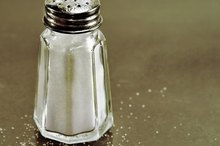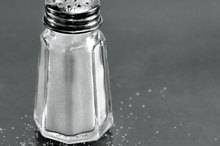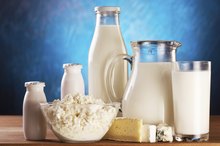What does fact checked mean?
At Healthfully, we strive to deliver objective content that is accurate and up-to-date. Our team periodically reviews articles in order to ensure content quality. The sources cited below consist of evidence from peer-reviewed journals, prominent medical organizations, academic associations, and government data.
- MayoClinic; Low-Sodium Diet; Katherine Zeratsky, R.D., L.D.; February 2011
- Cleveland Clinic: Low-Sodium Diet Guidelines
- MayoClinic: Guide to a High-Fiber Diet
The information contained on this site is for informational purposes only, and should not be used as a substitute for the advice of a professional health care provider. Please check with the appropriate physician regarding health questions and concerns. Although we strive to deliver accurate and up-to-date information, no guarantee to that effect is made.
High-Fiber & Low-Salt Diet
Increasing the amount of fiber in your diet has many health benefits, including lower blood cholesterol, normalized bowel movements and weight control. A reduction in salt intake lowers blood pressure and reduces your risk of heart disease. Following a high-fiber, low-salt diet can help you manage your health and avoid any major health problems 2.
Fiber Recommendations
Fiber recommendations differ based on age and sex. Males between the ages of 14 and 50 have the highest fiber needs at 38 g per day. When a man reaches the age of 51, fiber needs decrease to 30 g per day. Females between 14 and 18 should consume 36 g of fiber daily, whereas females between 19 and 50 should consume 25 g per day. Women aged 51 and older should consume 21 g of fiber every day.
- Fiber recommendations differ based on age and sex.
- Women aged 51 and older should consume 21 g of fiber every day.
Tips for Increasing Fiber
What Is the NAS Diet?
Learn More
Choose bran or whole grain cereals for breakfast instead of sugary, low-fiber varieties. Check labels and opt for cereals containing at least 5 g of fiber per serving. Add plenty of fresh fruits and vegetables into your diet. Eat the skin whenever possible, which contains a large amount of the fiber. Replace refined breads and pastas with whole-grain varieties. Opt for brown rice instead of white rice. While it is preferable to increase your fiber intake through the foods you eat, consider a fiber supplement if you find it hard to meet your needs. Talk with your health care provider before beginning any supplementation.
- Choose bran or whole grain cereals for breakfast instead of sugary, low-fiber varieties.
- Talk with your health care provider before beginning any supplementation.
Sodium Recommendations
The sodium guidelines for healthy adults are set at less than 2,300 mg per day. The lower you can get your sodium intake, the better. Cleveland Clinic notes that a reduction to less than 2,000 mg daily can be beneficial to healthy adults. For anyone with heart disease or high blood pressure, a sodium restriction of less than 1,500 mg daily may be most beneficial. A sodium restriction of less than 1,500 mg daily is also recommended for high-risk populations, such as African-Americans and middle-aged to elderly adults.
- The sodium guidelines for healthy adults are set at less than 2,300 mg per day.
- For anyone with heart disease or high blood pressure, a sodium restriction of less than 1,500 mg daily may be most beneficial.
Tips for Reducing Salt
Does Rinsing Tuna Get Rid of Sodium?
Learn More
One of the easiest ways to reduce salt is to increase the amount of fresh, whole foods you eat. Fruits, vegetables, fish and unprocessed grains are naturally low in sodium. Packaged foods, canned foods and frozen foods usually contain excessive amounts of salt. If you don’t have time to prepare fresh foods and must consume processed foods, choose low-sodium or sodium-free varieties whenever possible. Instead of adding salt during cooking, use fresh herbs, sodium-free spices or citrus juices.
Restaurant foods often contain a significant amount of sodium as well. Try to eat at home whenever possible. When you do eat out, request that the chef add no salt.
- One of the easiest ways to reduce salt is to increase the amount of fresh, whole foods you eat.
- Fruits, vegetables, fish and unprocessed grains are naturally low in sodium.
Related Articles
References
- Cleveland Clinic: Low-Sodium Diet Guidelines
- MayoClinic: Guide to a High-Fiber Diet
- Veronese N, Solmi M, Caruso MG, et al. Dietary fiber and health outcomes: an umbrella review of systematic reviews and meta-analyses. Am J Clin Nutr. 2018;107(3):436-444. doi:10.1093/ajcn/nqx082
- Slavin JL, Lloyd B. Health benefits of fruits and vegetables. Adv Nutr. 2012;3(4):506-516. doi:10.3945/an.112.002154
- Raspberries, raw. FoodData Central. U.S. Department of Agriculture. Published April 1, 2019.
- Edamame, shelled. FoodData Central. U.S. Department of Agriculture. Published April 1, 2019.
- El-Salhy M, Ystad SO, Mazzawi T, Gundersen D. Dietary fiber in irritable bowel syndrome (Review). Int J Mol Med. 2017;40(3):607–613. doi:10.3892/ijmm.2017.3072
- Ma Y, Hu M, Zhou L, et al. Dietary fiber intake and risks of proximal and distal colon cancers: A meta-analysis. Medicine (Baltimore). 2018;97(36):e11678. doi:10.1097/MD.0000000000011678
- Ma Y, Olendzki BC, Wang J, et al. Single-component versus multicomponent dietary goals for the metabolic syndrome: A randomized trial. Ann Intern Med. 2015;162(4):248-57. doi:10.7326/M14-0611
- Kim Y, Je Y. Dietary fibre intake and mortality from cardiovascular disease and all cancers: A meta-analysis of prospective cohort studies. Arch Cardiovasc Dis. 2016;109(1):39-54. doi:10.1016/j.acvd.2015.09.005
- Hajishafiee M, Saneei P, Benisi-Kohansal S, Esmaillzadeh A. Cereal fibre intake and risk of mortality from all causes, CVD, cancer and inflammatory diseases: a systematic review and meta-analysis of prospective cohort studies. Br J Nutr. 2016;116(2):343-52. doi:10.1017/S0007114516001938
- U.S. Department of Health and Human Services and U.S. Department of Agriculture. 2015 – 2020 Dietary Guidelines for Americans. 8th Edition.
- Juraschek SP, Miller ER 3rd, Weaver CM, Appel LJ. Effects of sodium reduction and the DASH diet in relation to baseline blood pressure. J Am Coll Cardiol. 2017;70(23):2841–2848. doi:10.1016/j.jacc.2017.10.011
Writer Bio
Lindsay Boyers has a Bachelor of Science in nutrition from Framingham State College and a certificate in holistic nutrition from the American College of Healthcare Sciences. She is also a licensed aesthetician with advanced training in skincare and makeup. She plans to continue on with her education, complete a master's degree program in nutrition and, ultimately, become a registered dietitian.








